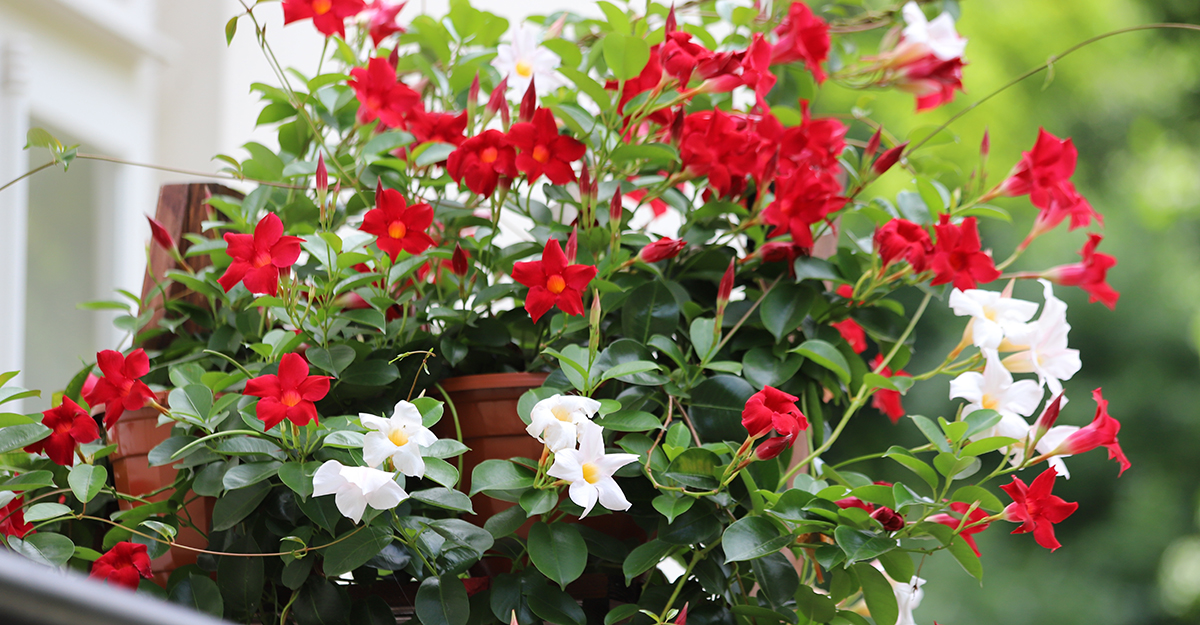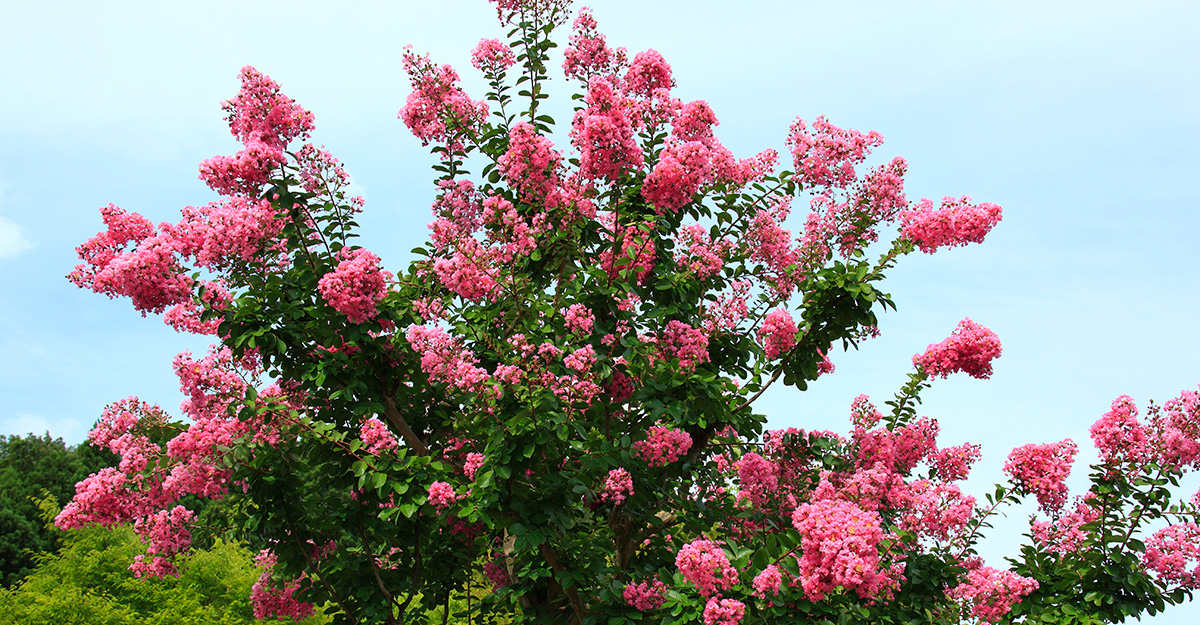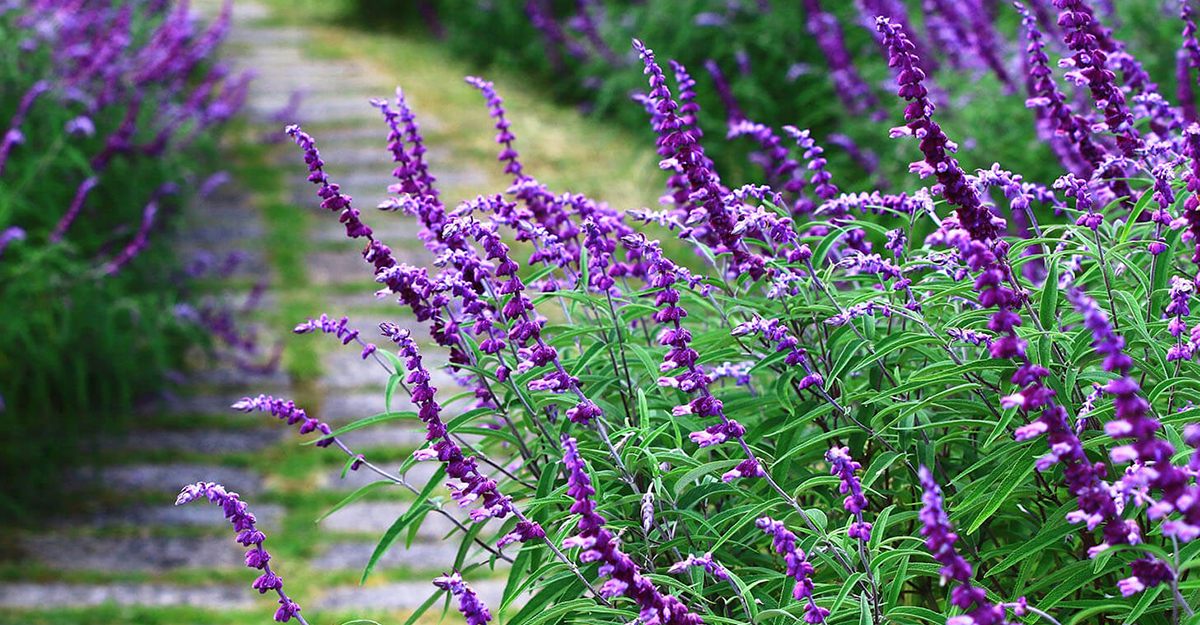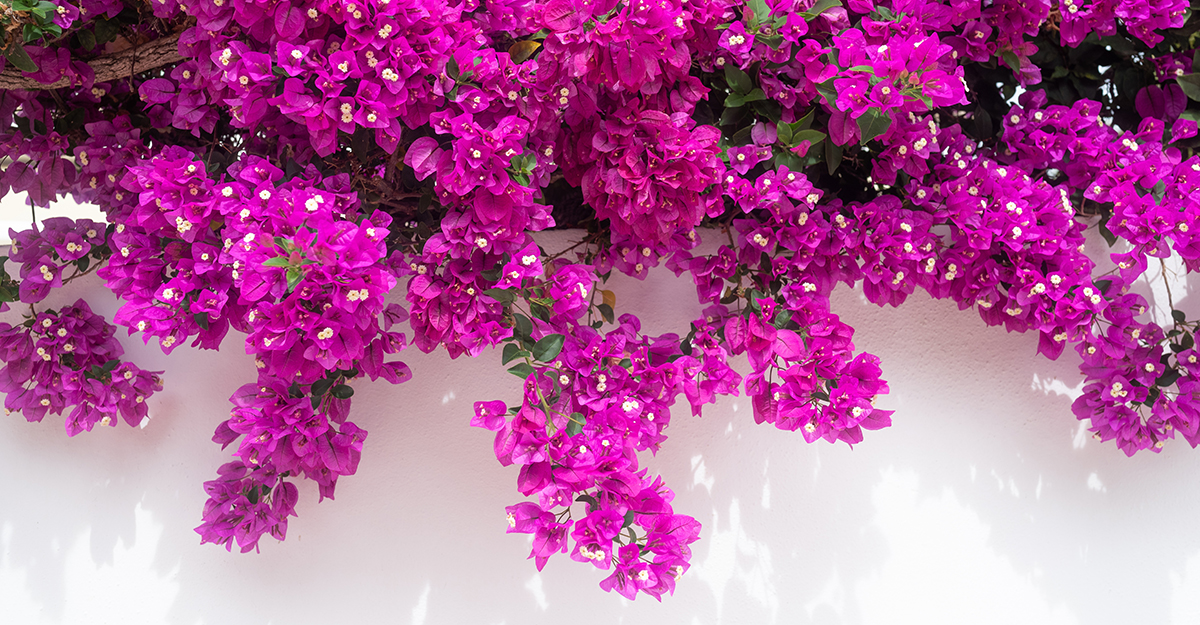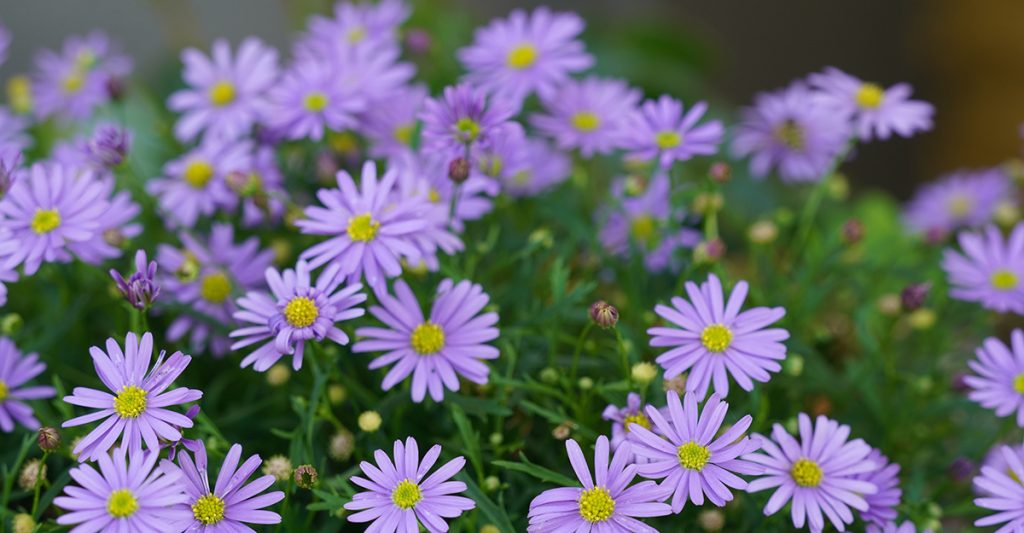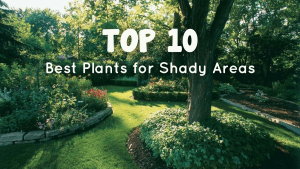Plants for a Colourful Garden
Let’s start with a Mandevilla shall we? They are so easy to grow, they love the sun and they will give you massive colourful flowers for weeks and weeks and weeks that start in around late November and will go on for weeks and weeks well into late January and early February. So they are a fabulous source of summer flowers.
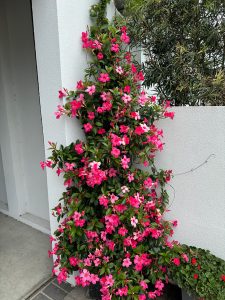 Now they’re kind of a half climbing plant and a half bush. So you can have them growing as just a bush or give them something to climb on. If they climb they will put on the most fabulous show of absolutely brilliant flowers. They come in many different colours from soft pinks to real electric pinks to even whites and rich deep reds. Now they might get beaten up a bit by summer rain storms but give them a couple of hot days and they will be looking all beautiful again. You can grow them in pots forever, just make sure you keep up the fertiliser and give them a nice sunny spot.
Now they’re kind of a half climbing plant and a half bush. So you can have them growing as just a bush or give them something to climb on. If they climb they will put on the most fabulous show of absolutely brilliant flowers. They come in many different colours from soft pinks to real electric pinks to even whites and rich deep reds. Now they might get beaten up a bit by summer rain storms but give them a couple of hot days and they will be looking all beautiful again. You can grow them in pots forever, just make sure you keep up the fertiliser and give them a nice sunny spot.
Another simple and easy plant to grow is the Calibrachoa. They are cheap to buy and they just give you colour right through Summer to probably mid-May or end of May, depending whenever the weather turns really cold. Now you can get lots of different colours of Calibrachoa, like whites and yellow and pinks and reds, so what I often tell people to do is to multi-plant your pots and planters with them. If you put three different colours in together then when they flower, they just come alive with colour and it’s a lot of fun. Or if you’ve got something like a standard Ficus in a pot or something like that, if you pop these all around the base of it, you can bring something that’s a little bit boring really to life.
Obviously along this particular part of the garden bed which is outside windows, they wanted something low growing that wouldn’t block the view and they got that with both these plants that can be kept nice and low.
If you happen to have a shadier part of your garden then something like Impatiens are a perfect option. They are a great source of summer colour. They will flower like crazy right through until the cold weather comes. And you can get them in mauves, pinks, purples, reds, oranges, yellows, all different colours. So Impatiens really are a great source of colour.
Another choice for summer colour in your garden is the Pansy, which is in your Viola family. Now Pansies come in all sorts of colours and multicolours and they’re a really hardworking plant that just keeps on flowering and flowering and flowering so they’re a great source of colour.
Then of course you’ve got your Geraniums, which are really easy to grow and being a perennial are a reliable, faithful source of colour. Once you get a nice Geranium in that you like, it’s easy to take cuttings and keep on putting them all around the place. They’re very, very easy to strike and grow.
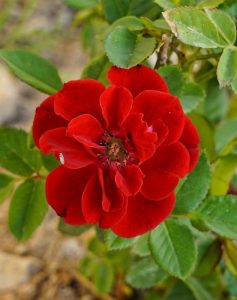 Now when you think of a plant that can really bring your garden to life in the summer, the first one some people think of is the Carpet Rose. Now they come in white, dark pink, apple blossom pink and one called Scarlet, which is a beautiful double red. And all of those carpet roses are great and in many ways are better than normal roses which can look a bit scraggly with one flower here and one flower there. But your carpet roses are a low dense bush with masses of flowers, particularly the pink ones. When they flower, the whole bush is absolutely covered, so covered in flowers that you can barely see the foliage and that gives you a really big hit of colour that other roses don’t give you.
Now when you think of a plant that can really bring your garden to life in the summer, the first one some people think of is the Carpet Rose. Now they come in white, dark pink, apple blossom pink and one called Scarlet, which is a beautiful double red. And all of those carpet roses are great and in many ways are better than normal roses which can look a bit scraggly with one flower here and one flower there. But your carpet roses are a low dense bush with masses of flowers, particularly the pink ones. When they flower, the whole bush is absolutely covered, so covered in flowers that you can barely see the foliage and that gives you a really big hit of colour that other roses don’t give you.
Carpet Roses tend to flower from spring right through to winter. So they’re tremendously hardworking plants. You can blend sort of light pink and dark pink and white together and they look really, really fabulous. They’re very easy to grow, last for years and will give you a really strong hit of colour with very little effort.
The next plant for summer colour to recommend is your Jacaranda. They give you those beautiful lilac-blue flowers in summer. And what’s beautiful is that the flowers, as they go through the flowering season, rain down on the ground and you get this magnificent lilac-blue carpet underneath that looks really, really fabulous. Now some people can get a bit frightened of how big a Jacaranda can grow, but these days you can get a dwarf Jacaranda called a Bonsai Jacaranda that will only grow to about 3 or 4 metres so it won’t get out of hand.

Another summer flowering tree that really gives you a good hit of colour is your Crepe Myrtle. Now you can get these in whites, you can get them in soft pinks, you can get them in hard, brilliant pinks. You can get them in sort of mauves, you can get them right through to purples. So there are a lot of different colours available. And what’s great about the Crepe Myrtle, is that it flowers in the hottest part of summer. Once it does, it will be flowering for weeks and weeks and weeks to come. Then not long after they finish flowering, you’ll get beautiful autumn colour and then they lose their leaves and what you’ll seen then is that they’ve got this magic sort of bark with beautiful patterns and shapes on the bark. So it’s a really good useful, hardy tree.
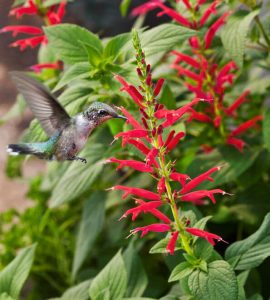 Another option you have today is the Salvia. Now Salvias give you absolutely brilliant summer colour. We’ve got plenty in the nursery, in purples or pinks or whites or mauves, all sorts of different colours and they just flower and flower all through the warm months. Some of them even flower right through the winter, not as densely in the winter as they do in summer but they still flower. So Salvia is a really great source of colour if you want really nice, brilliant colour.
Another option you have today is the Salvia. Now Salvias give you absolutely brilliant summer colour. We’ve got plenty in the nursery, in purples or pinks or whites or mauves, all sorts of different colours and they just flower and flower all through the warm months. Some of them even flower right through the winter, not as densely in the winter as they do in summer but they still flower. So Salvia is a really great source of colour if you want really nice, brilliant colour.
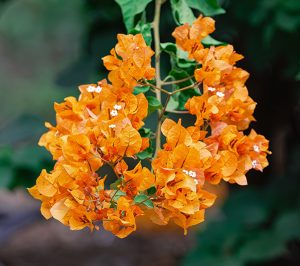
One more summer colour choice you can’t ignore is Bougainvillea. Now Bougainvillea is really, really colourful, with absolutely brilliant colours of all different shades and hues. The one that does best in Melbourne, particularly if you’re in the outer suburbs where it’s very cold in the winter, is one called Traillii, which is the deep purple one. But as you move towards the inner city, you can grow almost any of the Bougainvilleas such as reds, oranges, yellow, almost any of the different colours you can grow in the inner parts of Melbourne. Places like Brighton for example, and all the inner suburbs, you can grow almost any colour. But in the outer suburbs, in the country towns, it’s the Traillii, the purple one that are best to grow. They are very hardy, fast growing and cold tolerant. Even though it’s a little bit common it’s still an incredible source of a brilliant block of colour for quite a few months in the summertime.
 Another really great option for summer colour is your Blue Convolvulus which is quite an amazing plant. It starts flowering in the middle of September and goes all the way through till Autumn. It’s really, really hardy. I remember in one of those big long droughts we had a couple of decades ago there were all sorts of gardens in homes and in commercial places where people stopped watering altogether to save water. And everything in the garden died except for the Blue Convolvulus, which just kept growing and spread and ended up covering the whole garden. So during the drought you saw enormous gardens of Blue Convolvulus. Even the other day, I went past the local cemetery and there was an enormous patch of it. And it was just absolutely brilliant shimmering blue. There were so many flowers there that you couldn’t see the leaves. It was just a mass of blue in the hot sun. It was really, really beautiful.
Another really great option for summer colour is your Blue Convolvulus which is quite an amazing plant. It starts flowering in the middle of September and goes all the way through till Autumn. It’s really, really hardy. I remember in one of those big long droughts we had a couple of decades ago there were all sorts of gardens in homes and in commercial places where people stopped watering altogether to save water. And everything in the garden died except for the Blue Convolvulus, which just kept growing and spread and ended up covering the whole garden. So during the drought you saw enormous gardens of Blue Convolvulus. Even the other day, I went past the local cemetery and there was an enormous patch of it. And it was just absolutely brilliant shimmering blue. There were so many flowers there that you couldn’t see the leaves. It was just a mass of blue in the hot sun. It was really, really beautiful.
 Now you can get the Convolvulus in a form that has both blue and white flowers on the same bush. You can also get it with white flowers and you can get it with beautiful blue flowers each on separate bushes. And it’s one of the longest flowering plants around. It’s one that I’ll often plant underneath, say Iceberg Roses or something like that because I find that the blue really sets off your icebergs.
Now you can get the Convolvulus in a form that has both blue and white flowers on the same bush. You can also get it with white flowers and you can get it with beautiful blue flowers each on separate bushes. And it’s one of the longest flowering plants around. It’s one that I’ll often plant underneath, say Iceberg Roses or something like that because I find that the blue really sets off your icebergs.
Another alternative you might like is the Purple Brachyscome. Now the Brachyscome does come in a range of different colours like white but that variety doesn’t seem to flower for very long. But your purples and your blues and your pinky purples and pinky blues seem to last longer. So you have a few different choices of colour. There’s also like a cut leaf form and a fine leaf form. I’ve got them in my garden but you’ll spot them everywhere and they just lift the whole garden because they flower really, really well right through the heat of summer. Brachyscome is like your little native daisy, really, really handy. It’s a little round bush that you can use as a ground cover.
In Closing
 So like many of the plants I’ve mentioned for summer colour, you can use them to pick out those bare spots in your garden, and just plant some of them to give you splashes of colour here and there. One thing that not a lot of people think to do, is to underplant them. If you have something that has bare patches underneath it like a tree or a shrub, you can plant a lot of these summer colour plants below them and just add so much more colour to your garden. Or you can put some in hanging baskets or give them a place to climb in your garden. They are really cheap many of them.
So like many of the plants I’ve mentioned for summer colour, you can use them to pick out those bare spots in your garden, and just plant some of them to give you splashes of colour here and there. One thing that not a lot of people think to do, is to underplant them. If you have something that has bare patches underneath it like a tree or a shrub, you can plant a lot of these summer colour plants below them and just add so much more colour to your garden. Or you can put some in hanging baskets or give them a place to climb in your garden. They are really cheap many of them.
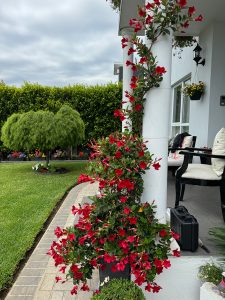 Something like the Mandevilla you can just keep as a bush but if you really want some visual impact you want to give it a little frame or trellis or something that will help it climb and it will give you some real height and much more colour in your garden.
Something like the Mandevilla you can just keep as a bush but if you really want some visual impact you want to give it a little frame or trellis or something that will help it climb and it will give you some real height and much more colour in your garden.
Now one problem some people can have with their flowering plants is getting them to flower abundantly and there is a little trick I can recommend. When you first plant them, it’s good to use a high nitrogen fertiliser to get them growing. But when they are well established you want to switch over to a high phosphorous fertiliser like MiracleGro which actually slows down the plants growth and causes it to produce flowers and buds. That will give you so many more flowers.
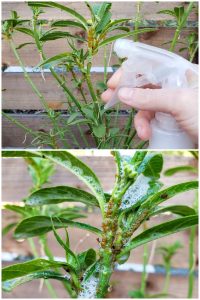 Another problem people might have with their flowering plants is aphids. Now these are one of the easiest things in the world to get rid of. Now if you’ve got kids and pets and you don’t want to put anything really toxic on your garden, I find that a bit of pyrethrum and a bit of dishwashing detergent mixed together and sprayed on your flowering plants that have Aphids will work wonders. Spray it once on a warm sunny day and then 48 hours later, do it again to get the next hatching of Aphids coming out and they will be done too. This mixture doesn’t have a residual poison and it’ll clean them up for good.
Another problem people might have with their flowering plants is aphids. Now these are one of the easiest things in the world to get rid of. Now if you’ve got kids and pets and you don’t want to put anything really toxic on your garden, I find that a bit of pyrethrum and a bit of dishwashing detergent mixed together and sprayed on your flowering plants that have Aphids will work wonders. Spray it once on a warm sunny day and then 48 hours later, do it again to get the next hatching of Aphids coming out and they will be done too. This mixture doesn’t have a residual poison and it’ll clean them up for good.
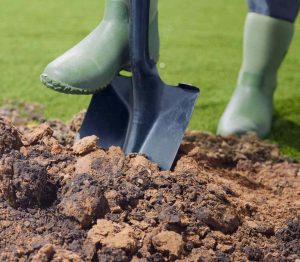 Now if you have clay soil, it’s nowhere near as bad as what some people reckon for flowering plants. Clay soil is millions of years old and it has got lots of nutrients in it. But the main problem with your clay soil is the clay particles in it are all squashed tight together. Now plant roots need water and oxygen and they both can’t move well through heavy clay soil. So when planting your flowering plants in a clay soil, dig a nice big hole, much bigger than you probably think and mix your potting mix and the clay soil together and that is even better than just the potting mix on its own. (But always use a good quality potting mix, not a cheap one!) With the mix of clay soil and potting mix, you’ve got a lot of minerals for the plant plus there are air gaps in the soil mix for the plant roots to grow into and get the oxygen they need and for the water to flow through it. So, so long as you break up the clay soil and mix it with the potting mix, your plants will do OK.
Now if you have clay soil, it’s nowhere near as bad as what some people reckon for flowering plants. Clay soil is millions of years old and it has got lots of nutrients in it. But the main problem with your clay soil is the clay particles in it are all squashed tight together. Now plant roots need water and oxygen and they both can’t move well through heavy clay soil. So when planting your flowering plants in a clay soil, dig a nice big hole, much bigger than you probably think and mix your potting mix and the clay soil together and that is even better than just the potting mix on its own. (But always use a good quality potting mix, not a cheap one!) With the mix of clay soil and potting mix, you’ve got a lot of minerals for the plant plus there are air gaps in the soil mix for the plant roots to grow into and get the oxygen they need and for the water to flow through it. So, so long as you break up the clay soil and mix it with the potting mix, your plants will do OK.
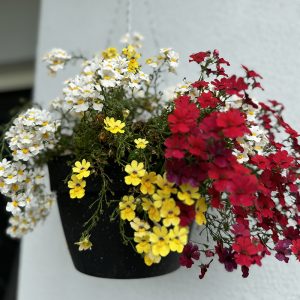 Now don’t forget when you are planting your colourful flowering plants in baskets and pots and so on, you can mix up different colours in the same basket or pot and that makes for some fun and interest.
Now don’t forget when you are planting your colourful flowering plants in baskets and pots and so on, you can mix up different colours in the same basket or pot and that makes for some fun and interest.
So there you go. I’ve given you 10 choices for adding some summer colour to your garden. So go on, splash out on some colour to liven up your garden, you won’t regret it!



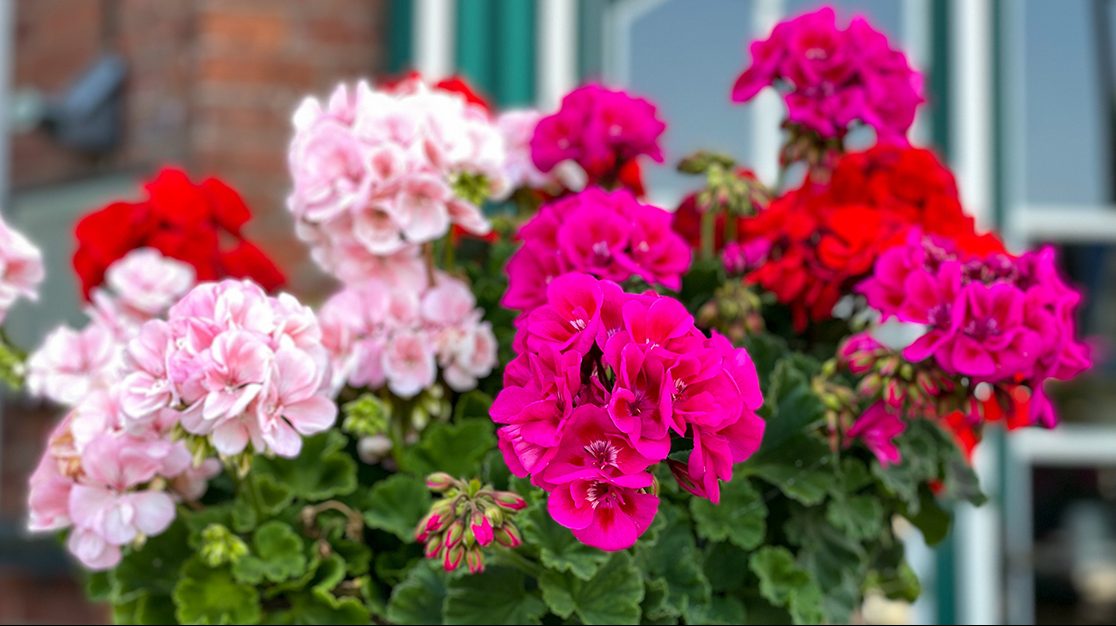





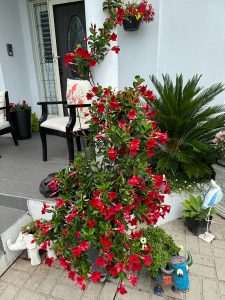 They had beautiful,
They had beautiful, 